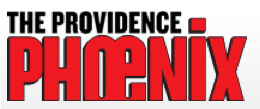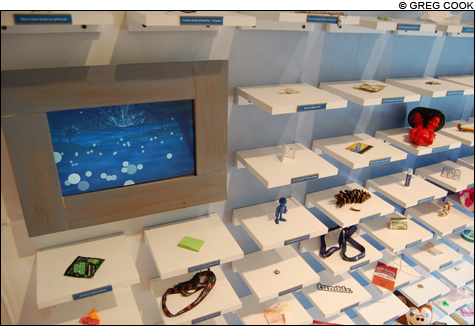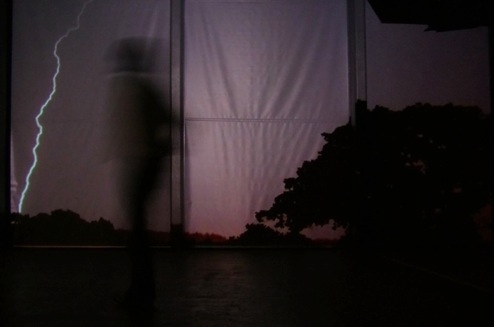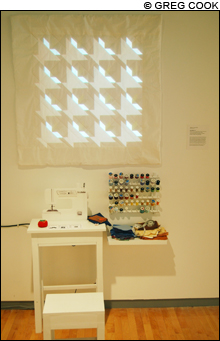news | upcoming


“Works are more moving when they're (apparently) simpler, allowing the content of the art to come to the fore.... Georgie Friedman’s [“Light of the Storm”] filled [the room] with the sound of wind and thunder, then intermittent flashes of red and white light behind silhouetted trees.... the presentation — particularly the sound — transforms the gray room into the outdoors.”

press
Pixilerations Review
September 27, 2011

TENUOUS CONNECTIONS Smith’s Digital Painting: Social Network.
Rebecca Mushtare's StoryQuilt invites you to sit at a faux sewing machine and tell it a story, which the Mount Kisco, New York, artist's software converts into a virtual quilt that is projected on the wall above. I leaned into the microphone and spoke about a 2-year-old boy upset by a scene in the movie Ponyo. As soon as I finished talking, it spit out a pattern of black-and-gray triangles in a variation of a flying geese quilt, inspired only by the "duration, volume, frequency" and other "measurable components" of my tale.
What does it mean to reduce our stories to simple measurements of their dimensions? This sort of sabermetrics approach to life is common among the 40 artists from around the globe exhibiting in "Pixilerations," the eighth annual festival of tech art organized by FirstWorks in Providence through October 2. (I'm focusing on exhibits, but there's also an okay pair of billboards in the parking lot at Page and Pine streets, and a concert of electronic music at Firehouse 13, 41 Central Street, Providence, on September 30.) Moneyball has demonstrated the benefits of analyzing baseball performance data to discover what sports talents really help win games and discover a deeper, more accurate understanding of this human phenomenon. But artists' data mining often disconnects from the soul of the thing — in the case Mushtare's StoryQuilt, which is among the works on view at RISD's Sol Koffler Gallery (169 Weybosset Street,). Don't we lose something important if we don't pay any attention to the content of our stories?

Friedman’s Light of the Storm
Often the needs of tech in tech art get in the way of the art. Works are more moving when they're (apparently) simpler, allowing the content of the art to come to the fore. At Brown University's Granoff Center for the Creative Arts (154 Angell Street),
Georgie Friedman of Boston describes her installation as video of a lightning storm projected across one wall of a Granoff room. It's mostly dark, the room filled with the sound of wind and thunder, then intermittent flashes of red and white light behind silhouetted trees. The work is pretty straightforward, but the presentation — particularly the sound — transforms the gray room into the outdoors.
Il Jeffuria Pizza, an interactive video installation by Jeffu Warmouth of Fitchburg, Massachusetts, offers a touch-screen menu of pizzas that prompt video of a life-sized Warmouth in a chef's hat to act out wacky orders. Order "Baseball Pizza" and he swings a rolling pin at balls of dough thrown his way; order "UFO Pizza" and a pie floats down (on very visible wires) for Warmouth to add pepperoni and cheese. It's lite comedy in the tradition of silent film comedians, William Wegman, and Sesame Street.

I Love You, Be Safe by Ian Alan Paul of San Francisco is video headshots of performers giving overlapping, monotone readings of lines like "Baby, where are you," "You need an ID to get in," "Take care." Lines like "Pentagon hit" slowly clue you in that the words come from text messages sent on September 11, 2001. It's powerful material, but the voices become an irritating cacophony.
TEXTILE TALE Mushtare’s StoryQuilt.
Read Greg Cook's blog at gregcookland.com/journal.
Museum And Gallery
all images, video and other content © georgie friedman